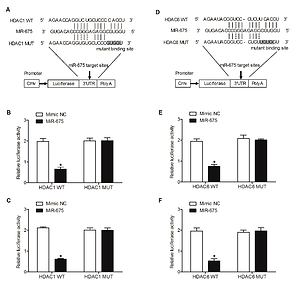Current issue
Archive
Manuscripts accepted
About the Journal
Editorial office
Editorial board
Section Editors
Abstracting and indexing
Subscription
Contact
Ethical standards and procedures
Most read articles
Instructions for authors
Article Processing Charge (APC)
Regulations of paying article processing charge (APC)
NEPHROLOGY / CLINICAL RESEARCH
Curcumin affects the prognosis of renal cell carcinoma through a negative feedback loop of H19/miR-675/HDAC/CTCF
1
Zhejiang Pharmaceutical College, Ningbo, Zhejiang, China
2
College of Pharmaceutical Science, Zhejiang Chinese Medical University, Hangzhou, Zhejiang, China
Submission date: 2019-09-07
Final revision date: 2020-02-01
Acceptance date: 2020-03-12
Online publication date: 2021-04-04
KEYWORDS
TOPICS
ABSTRACT
Introduction:
The objective of this study was to explore the role of curcumin (CUR) in the control of renal cell carcinoma (RCC) as well as the molecular mechanism underlying the effect of CUR.
Material and methods:
Real-time PCR, Western blot analysis, immunohistochemistry (IHC) assay, and luciferase assay were utilized to detect the effect of CUR.
Results:
Mesoscale nanoparticles (particles) could be safely and preferentially accumulated in the kidney in a dose-dependent manner, and the specific localization of particles in the kidney reached its maximum level at a dose of 25 mg/kg. Treatment with CUR alleviated RCC by up-regulating the expression of H19 and miR-675 while down-regulating the expression of HDAC1 and HDAC6 in RCC rats. Furthermore, the underlying mechanism of CUR in the regulation of H19 was explored, and it was revealed that CUR increased H19 expression via increasing the translational efficiency of the H19 promoter. Therefore, the treatment with CUR increased the levels of H19 and miR-675 while reducing the expression of HDAC1 and HDAC6. According to a computational analysis, HDAC1 and HDAC6 were both direct targets downstream of miR-675, and miR-675 mimics could decrease the luciferase activity of cells transfected by wild-type HDAC1 and HDAC6 3’UTR. In addition, miR-675 but not CTCF reduced the protein levels of HDAC1 and HDAC6. Nevertheless, CTCF increased the luciferase activity of cells transfected by the H19 promoter, while miR-675 mimics decreased the effect of CTCF.
Conclusions:
This study suggested that CUR could affect the prognosis of RCC by establishing a negative feedback loop of H19/miR-675/HDAC/CTCF.
The objective of this study was to explore the role of curcumin (CUR) in the control of renal cell carcinoma (RCC) as well as the molecular mechanism underlying the effect of CUR.
Material and methods:
Real-time PCR, Western blot analysis, immunohistochemistry (IHC) assay, and luciferase assay were utilized to detect the effect of CUR.
Results:
Mesoscale nanoparticles (particles) could be safely and preferentially accumulated in the kidney in a dose-dependent manner, and the specific localization of particles in the kidney reached its maximum level at a dose of 25 mg/kg. Treatment with CUR alleviated RCC by up-regulating the expression of H19 and miR-675 while down-regulating the expression of HDAC1 and HDAC6 in RCC rats. Furthermore, the underlying mechanism of CUR in the regulation of H19 was explored, and it was revealed that CUR increased H19 expression via increasing the translational efficiency of the H19 promoter. Therefore, the treatment with CUR increased the levels of H19 and miR-675 while reducing the expression of HDAC1 and HDAC6. According to a computational analysis, HDAC1 and HDAC6 were both direct targets downstream of miR-675, and miR-675 mimics could decrease the luciferase activity of cells transfected by wild-type HDAC1 and HDAC6 3’UTR. In addition, miR-675 but not CTCF reduced the protein levels of HDAC1 and HDAC6. Nevertheless, CTCF increased the luciferase activity of cells transfected by the H19 promoter, while miR-675 mimics decreased the effect of CTCF.
Conclusions:
This study suggested that CUR could affect the prognosis of RCC by establishing a negative feedback loop of H19/miR-675/HDAC/CTCF.
Share
RELATED ARTICLE
We process personal data collected when visiting the website. The function of obtaining information about users and their behavior is carried out by voluntarily entered information in forms and saving cookies in end devices. Data, including cookies, are used to provide services, improve the user experience and to analyze the traffic in accordance with the Privacy policy. Data are also collected and processed by Google Analytics tool (more).
You can change cookies settings in your browser. Restricted use of cookies in the browser configuration may affect some functionalities of the website.
You can change cookies settings in your browser. Restricted use of cookies in the browser configuration may affect some functionalities of the website.



